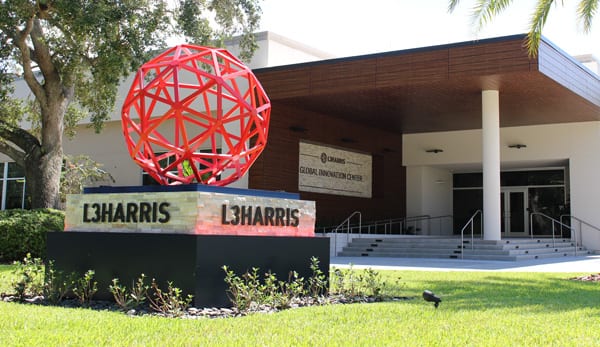Latest News

L3Harris corporate headquarters in Melbourne, Florida. Photo: L3Harris
L3Harris Technologies last Friday reported a big drop in proforma net income due to the sale of its security detection and automation business, costs related to the ongoing pandemic, and merger costs related to the acquisition of L3 Technologies by Harris Corp. last summer.
Pro forma sales were flat at $4.4 billion as growth in three of the company’s four segments was offset by a decline in revenue at the Aviation Systems segment largely due to the sale in May of its security detection and automation business to Leidos and costs associated with COVID-19.
Excluding revenue from the divested business, organic growth was just over 2%, driven by an 8% increase in U.S. government business that was partially offset by a decline in commercial work, mainly related to COVID-19.
The increase in organic revenue was driven by a ramp up in avionics for the F-35 fighter, classified growth in intelligence and cyber markets, electro-optical and maritime systems, and Defense Department tactical communication and integrated vision systems.
Pro forma results assume the merger between Harris and L3 was in effect throughout the second quarter of 2019. The acquisition closed on July 1, 2019, the start of the third quarter.
Pro forma net income fell 33 percent to $278 million, $1.30 earnings per share (EPS), from $416 million ($1.82 EPS) a year ago. Adjusting for the divestiture, discontinued operations, merger and integration costs, and COVID charges, adjusted earnings of $2.83 EPS were up 13 percent from a year ago and topped analysts’ estimates by 21 cents.
L3Harris attributed the higher adjusted earnings to cost saving synergies related to the merger, higher organic sales and operational performance, lower share count and a pension benefit.
Cost saving synergies resulting from the merger are ahead of plan, the company said, and net savings of $300 million will be reached in 2021, a year ahead of schedule.
The company remains focused on creating an enterprise operating entity with strong cross-segment collaboration and coordination and moving away from the legacy holding company model, William Brown, chairman and CEO of L3Harris, and Chris Kubasik, vice chairman, president and chief operating officer, said on the company’s earnings call.
Part of the shift toward an operating company model is a sharper focus on internally funded research and development, they said.
Brown said a review by the company’s chief technology officer found that R&D projects were “distributed deeply and broadly across the company, not centrally coordinated, no clear business rationale across the individual investments” and in some cases duplicative. Now the company can “focus that firepower” on fewer opportunities, he said, and “sharpen our focus on key strategic themes around spectrum superiority, actionable intelligence and warfighter effectiveness while positioning for the shift to an integrated networked battlefield. We are investing heavily in multi-function software-defined open architecture systems that allow us to deliver mission solutions independent of the platform.”
Kubasik added that “internally and externally, this is about optimizing, you know, the enterprise. The greater good of L3Harris versus optimizing the divisions. A more centralized, holistic approach enables the company to “prioritize those to get the greater growth and the greater returns.”
Brown said that the merger has already begun to unleash revenue synergies, referring to business opportunities that neither company was in a position to bid on their own prior to the combination, and that the collaboration between segments to identify new opportunities is now “nearly self-sustaining.” He and Kubasik both said the company is in the early innings of unlocking potential revenue synergies and further boosting operating margin.
Brown also said the company is focused on its working capital and expects “substantial improvements” come 2022 that will bring free cash flow to $3 billion with growth beyond. This year the forecast for free cash flow is between $2.6 billion and $2.7 billion, in line with prior guidance.
Last Friday, L3Harris completed the sale of its EOTech holographic sighting systems and magnified field optics business to American Holoptics. Brown said the company is now one-third of the way through divesting about eight to 10 percent of revenue from non-core businesses. Additional divestitures are ahead in the coming quarters, he said.
Free cash flow in the quarter was $785 million and orders outpaced sales. Funded backlog is up 5 percent since the start of the year.
The financial outlook for 2020 is unchanged, with sales forecast between $18.2 billion and $18.6 billion and adjusted earnings between $11.15 and $11.55 EPS.
This article was originally published by our sister publication Defense Daily.
Get the latest Via Satellite news!
Subscribe Now